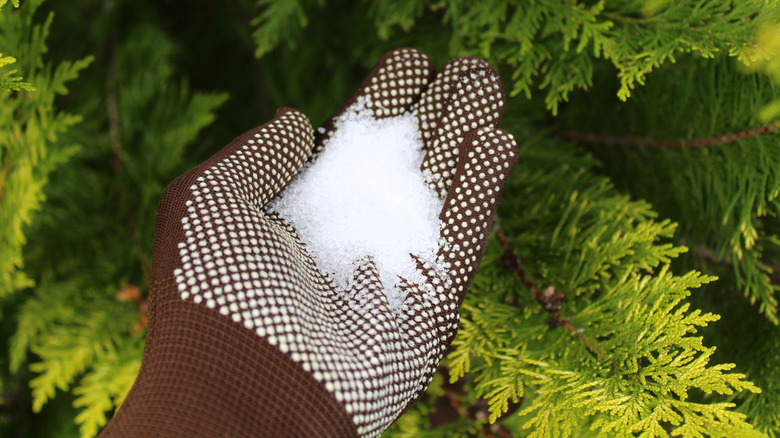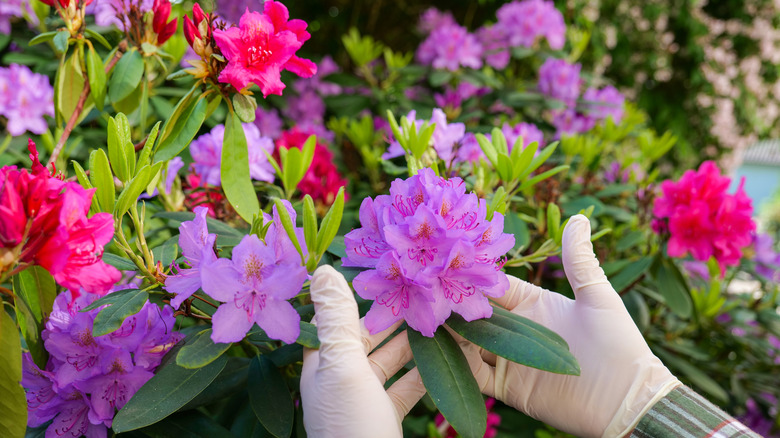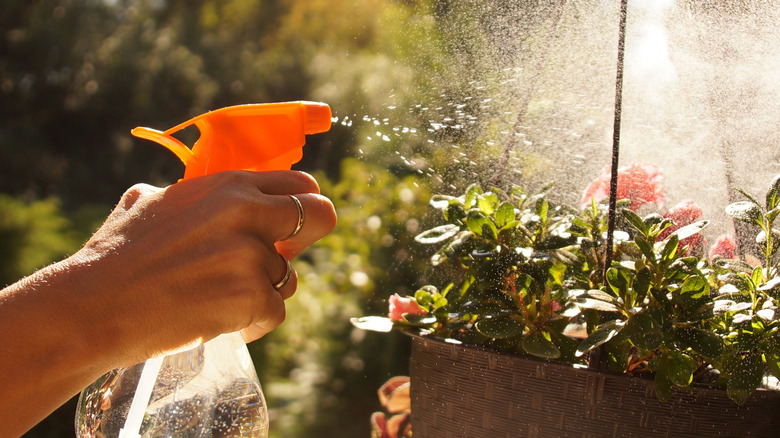The Flowering Shrubs That Benefit From A Bit Of Epsom Salt In The Garden
While many common household items can be used as natural fertilizer, few can be found in the bath aisle. But that's the beauty of Epsom salt, or magnesium sulfate, a compound that is good for more than a soak in the tub. Known for its ability to soothe muscle soreness and joint pain, Epsom salt is a helpful source of magnesium and sulfur in a nutrient-lacking garden. And for perennial shrubs like rhododendrons and azaleas, whose leaves may yellow due to nutrient deficiencies, it can be a lifeline.
Magnesium is not just a beneficial element — it is a crucial component of chlorophyll, the chemical that helps plants photosynthesize and gives leaves their signature green hue. Sulfur is a necessary element for proper plant growth and development. Soil lacking in these nutrients can lead to stunted plant growth, discoloration, and, in extreme cases, cell death. For rhododendrons and azaleas, these deficiencies can cause chlorosis, a yellowing of the leaves that primarily affects the smooth areas between leaf veins.
If a nutrient deficiency is detected, applying a controlled dose of Epsom salt can correct these levels, allowing your rhododendron to make a full recovery. However, there are risks to using Epsom salt in the garden, so take extra care when treating your plants.
Using Epsom salt to help your rhododendrons thrive
Rhododendrons and azaleas (Rhododendron spp.), members of the Ericaceae, or blueberry, family, are closely related flowering shrubs robust in USDA Hardiness Zones 4 through 8. Although these plants look similar, you can tell rhododendrons and azaleas apart easily by the flower structure and number of stamens. Both plants prefer to grow in acidic soil and are light feeders, meaning they rarely require heavy fertilization. But when planted in sandy, quick-draining, or nutrient deficient soil, these spring bloomers may begin to show signs of stress by developing patches of spotty yellow leaves. Left untreated, the leaves will turn brown and may drop from the plant entirely.
Luckily, there are several ways to combat this deficiency with Epsom salt. To treat the foliage directly, dilute one ounce of Epsom salt per gallon of water and spray evenly across the affected leaves. This method of topical application is preferable for plants that are already showing signs of distress. To proactively amend an area with nutrient-deficient soil, experts recommend applying one tablespoon of Epsom salt per 9 square feet of garden space before planting. Since this method allows salt to dissolve into the soil naturally, there is no need to mix it with water.
Mistakes to avoid when gardening with Epsom salt
Despite Epsom salt's benefits in the garden, its use is not without risk. Heavy concentrations of salt may cause leaf scalds, and too much magnesium can stunt plant growth. But there are a few easy ways to make sure you are not harming your rhododendrons and azaleas. First, properly dilute your solution before applying a topical spray to correct a magnesium deficiency. Try testing your solution on a small section of leaves before treating the entire plant. If the treated leaves decline, you may need to add more water to your solution.
Since many nutrient deficiencies can present in similar ways, it is important to identify which nutrient your soil is lacking before deciding the best solution. Iron-deficient plants may look like magnesium-deficient plants, and adding too much magnesium to the soil may prohibit the plant's roots from soaking up calcium, another crucial element for plant health. Evaluating your soil is the best way to ensure you are giving your plants what they need. Many stores sell soil test kits, or you can learn how to make a DIY soil test to check your soil's health. Once you detect a magnesium or sulfur deficiency, you can use these tips to confidently treat your rhododendrons and azaleas with Epsom salt.


